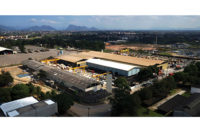With the issue that you currently hold in your hands, Stone World Magazine officially marks 25 years of covering the international stone industry. I’ve been with the magazine for 17 of those years, and if I could have written this column two and a half years ago, I’d be able to say that it has been an overwhelmingly positive experience. Up until the current, lingering recession, I can honestly say that I never saw this industry go through any hard times. U.S. consumption of stone grew each and every year - by a lot - and it seemed that people were prospering at all levels.
With this being such a young industry - especially among stone fabricators - I think many people had the same perspective as me. Business steadily increased, with few hiccups or road bumps along the way. We are talking about a decade and a half of non-stop growth. The industry was so filled with success that it was palpable at trade shows around the world.
Today, of course, we see a very different landscape out there. Businesses - both good and bad - have closed their doors. Respected companies have laid off employees in multiple waves. Although it appears we have turned the corner, it has been the darkest hour of our industry.
But even with all of that bad news, that doesn’t mean we haven’t come a long way as an industry over the past 25 years.
Back in 1984, the U.S. “stone industry” was very different than it was today. Sure, there were marble and granite quarriers in places like Vermont and Texas and Minnesota; and there were great monument builders in Vermont and Georgia. There were even a few large-scale stoneworking plants that built skyscrapers, mostly in the Northeast but also in places like Indiana, where the stone was cut for the Empire State Building.
But even with all of this in place, the stone industry was very small in 1984, even compared to today’s industry. Today, the U.S. stone industry is more advanced than it has ever been before. Between trade associations and industry events, the opportunities for networking and education are far greater than they were 25 years ago. Meanwhile, the Internet has provided yet another forum for stone industry members to share ideas and information with their colleagues.
Of course, none of these avenues for information are any good without the cooperation of the industry itself. In this regard, the stone industry has impressed me to no end. The good shops out there take pride not only in their own work, but in the trade as a whole. This is why you see them passing along advice to the industry at large - whether it is at a demonstration at StonExpo or sharing personal experiences at one of the many forums that take place around the country. This, too, was largely absent from our industry 25 years ago.
The same applies to the stoneworking businesses that allow me and my camera into their workplace. Whether it is a large-scale fabrication plant in Brazil or a newly opened fabrication shop in New Jersey, stone industry members have been amazingly welcoming to me, and by doing so, they are sharing their knowledge with the industry as a whole. For that, I am personally grateful.
And as for this recession, I am told this is not the first time that the stone industry has had to bounce back from hard times. In the early 1990s, when the building boom of the previous decade virtually halted all commercial work - the backbone of American stone consumption at the time - the situation was also grim. I wasn’t with Stone World at that time, but our Publisher, Alex Bachrach, remembers the industry shifting to meet changing times. “That was about the time that the kitchen countertop emerged as a consistent area for growth,” he said. “Fabrication shops started investing in machinery that mostly had been in use at large-scale factories, and they started becoming much more price competitive compared to the traditional countertop surfaces.”
Ultimately, the industry reinvented itself and built itself to a point where it was stronger than ever. Something tells me that the current version of the stone industry will be just as resilient.
Marking 25 years of Stone World
Looking for a reprint of this article?
From high-res PDFs to custom plaques, order your copy today!




